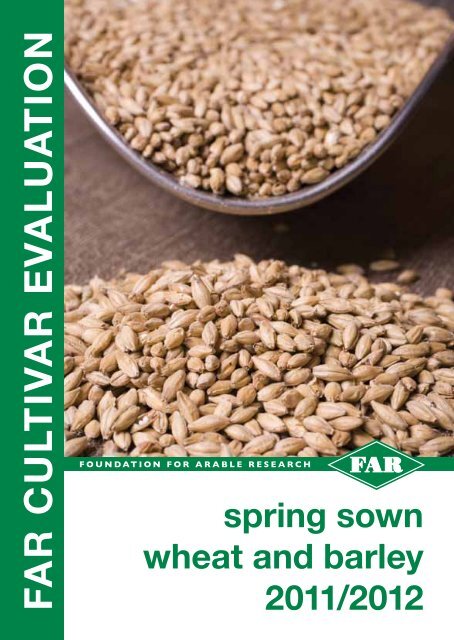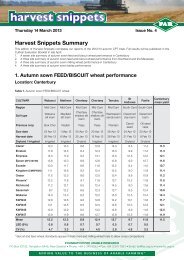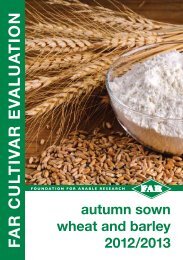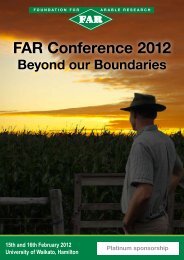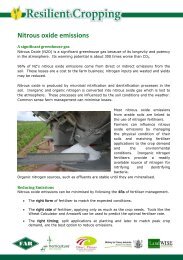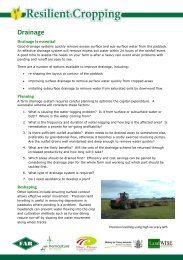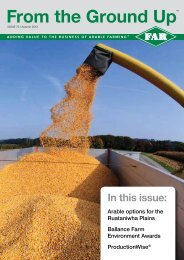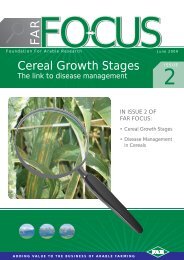to view pdf of Spring sown wheat and barley 2011/2012
to view pdf of Spring sown wheat and barley 2011/2012
to view pdf of Spring sown wheat and barley 2011/2012
- No tags were found...
You also want an ePaper? Increase the reach of your titles
YUMPU automatically turns print PDFs into web optimized ePapers that Google loves.
FAR CULTIVAR EVALUATIONFOUNDATION FOR ARABLE RESEARCHspring <strong>sown</strong><strong>wheat</strong> <strong>and</strong> <strong>barley</strong><strong>2011</strong>/<strong>2012</strong>
page2 notes
introduction <strong>and</strong> welcomepage3It is great <strong>to</strong> see some <strong>of</strong> the newer cultivarentrants performing well. For the spring feed<strong>barley</strong>s, Garner, Sumit, CRBA133 <strong>and</strong> CRBA124all yielded above 7.8 t/ha, the four year rollingaverage. The spring milling <strong>wheat</strong> CRWT151yielded well for the second year in a rowcombined with good quality characteristics.Sensas yielded well this past season comparedwith the previous season.Overall spring <strong>barley</strong> yields for <strong>2011</strong>-12 wereclose <strong>to</strong> the 4 year mean in the southernNorth Isl<strong>and</strong> (6.9 t/ha). However the yield inCanterbury was up on the 4 year mean at 8.5 t/ha compared with 7.8 t/ha, reflecting the cooler<strong>and</strong> wetter season.collaborating <strong>and</strong> including their cultivars forthe overall good <strong>of</strong> the industry. CPT is the onlyindependent source <strong>of</strong> information you haveavailable when making decisions on cultivars.We encourage you <strong>to</strong> use the information inthese booklets <strong>to</strong> make sound cultivar decisions.FAR welcomes any queries or suggestions <strong>to</strong>further improve these booklets, or if you requireany additional information that we have notincluded please contact us.Rob CraigieProject ManagerOne <strong>of</strong> the regular trial sites (Chat<strong>to</strong>n spring<strong>barley</strong>) is not reported due <strong>to</strong> flood damage.The CPT system has been running effectivelyfor over thirty years. The success <strong>of</strong> the systemhas been paramount <strong>to</strong> the ongoing geneticimprovement we have seen in cereal cultivars inNew Zeal<strong>and</strong>. This system relies on companies© This publication is copyright <strong>to</strong> the Foundation for Arable Research <strong>and</strong> may not be reproducedor copied in any form without written permission from FAR.This document is intended <strong>to</strong> provide accurate <strong>and</strong> adequate information relating <strong>to</strong> the subjectmatter contained in it. It has been prepared <strong>and</strong> made available <strong>to</strong> all persons <strong>and</strong> entities,strictly on the basis that FAR, its researchers <strong>and</strong> authors are fully excluded from liability fordamages arising out <strong>of</strong> any reliance in part, or in full, upon any <strong>of</strong> the information for any purpose.No endorsement <strong>of</strong> named products is intended, nor is any criticism <strong>of</strong> other alternative, butunnamed products.
page5herbicide applications were completed usingCougar, Axall, Starane, Versatil <strong>and</strong> Twinax.Two applications <strong>of</strong> Mavrik insecticide wereapplied in late Oc<strong>to</strong>ber <strong>and</strong> early November. Afungicide program including Proline <strong>and</strong> Amistarwas applied in early December <strong>and</strong> Falconwas applied later December. A PGR was alsoapplied in November. The trial received 105 mm<strong>of</strong> irrigation in three applications. The trial washarvested on 15 March <strong>2012</strong>.CHATTON - SOUTHLANDJacobs<strong>to</strong>wn silt loam, Dryl<strong>and</strong>Trial opera<strong>to</strong>r: Stewart Armstrong,Plant & Food ResearchHost farmer: Graeme GardyneThe trial was <strong>sown</strong> on 11 Oc<strong>to</strong>ber <strong>2011</strong> in<strong>to</strong> asurrounding field <strong>of</strong> Armstrong oats followingpasture. The trial received 138 kg N/ha duringthe season. Two herbicide applications weremade, a Glean <strong>and</strong> Trimec mix <strong>and</strong> Starane. Tw<strong>of</strong>ungicides (Opus mix) were applied as well. APGR, Cycocel was applied. Some bird damagewas noted in awnless cultivars. The trial washarvested on 11 April <strong>2012</strong>.
page6 <strong>wheat</strong> - agronomic comment<strong>Spring</strong> Sown Wheat Agronomic Comment <strong>2011</strong>/<strong>2012</strong> SeasonCULTIVARYearsin FARtrialsBYDVScoresSep<strong>to</strong>rialeafblotchStriperustLeaf rust PowderymildewFusariumheadblightStrawstrengthCropheightMaturitySproutingsusceptibilityConquest 9 MS MR MR MSS MS MS Mod-stiff Moderate Early-int LowMajestic(CRWT139)2 Unknown MR MRR MRR MS Unknown Stiff Short-mod Int-late ModerateMorph 11 MS MS MRR MS* R MR Weak-mod Moderate Intermediate LowRaffles 10 MS MR MSS MSS MR MS Moderate Tall Intermediate LowSage 6 Unknown (MR) MSS MR MRR MR Weak-mod Tall Int-late LowSaracen 2 Unknown MR MR MSS MR MS Stiff Short Intermediate LowSensas(KSW083)2 Unknown Unknown (MR) Unknown (MR) Unknown Stiff Moderate Early LowTorlesse 15 S MSS MS* MR* MRR MS Stiff Short-mod Intermediate Mod-highCRWT151 2 Unknown (MS) (MS) MS (MS) Unknown Stiff Short Intermediate LowScores followed by * indicate resistance is affected by pathotypes present (score is an average).Scores in brackets indicate based on limited information.“Unknown” indicates there is insufficient trial information in NZ <strong>to</strong> assess resistance.Disease susceptibility comments are sourced from FAR funded Disease Nurseries carried out byPlant & Food Research, <strong>and</strong> assessments on FAR Cultivar Evaluation trials.Sprouting susceptibility comments are sourced from FAR funded Sprouting Nurseries carried out byPlant & Food Research.(brackets) = one year data/experience only.KeyS = susceptibleMSS = mostly susceptibleMS = moderately susceptibleMR = moderately resistantMRR = mostly resistantR = resistant
<strong>wheat</strong> - <strong>2011</strong>/<strong>2012</strong> yield (t/ha)page7<strong>Spring</strong> Sown Wheat Cultivar Evaluation <strong>2011</strong>/<strong>2012</strong> Season - yield (t/ha)CULTIVAR Kairanga 1 Darfield Methven WakanuiRegion ManawatuSoil typeKairanga siltloamCentralCanterburyTemple<strong>to</strong>nsilt loamMidCanterburyLyndhurstsilt loamMidCanterburyWakanui siltloamCanterburymean yieldChat<strong>to</strong>nSouthl<strong>and</strong>Jacobs<strong>to</strong>wnsilt loamSeasons inFAR trials(<strong>Spring</strong><strong>sown</strong>)Dryl<strong>and</strong> / Irrigated Dryl<strong>and</strong> Irrigated Irrigated Irrigated Dryl<strong>and</strong>Previous crop Wheat Peas Ryegrass Faba beans PastureSow date 23 Nov 2 Aug 5 Sep 14 Sep 11 OctHarvest date 11 Apr 15 Mar 17 Mar 15 Mar 11 AprConquest 8.4 6.4 7.7 9.9 8.0 7.4 9Majestic (CRWT139) 8.1 8.4 7.2 9.4 8.4 8.7 2Morph 8.2 8.8 8.1 10.9 9.3 - 11Raffles 10.2 8.1 8.8 11.1 9.3 - 10Sage 9.8 8.6 8.1 10.6 9.1 8.0 6Saracen 6.8 7.7 7.6 9.7 8.3 7.9 2Sensas (KSW083) 9.1 - 8.4 10.4 9.1 8.0 2Torlesse 8.7 7.6 7.9 9.6 8.3 - 15CRWT151 9.1 8.5 8.3 10.6 9.1 8.1 2Site meanyield (t/ha)8.7 8.0 8.0 10.3 8.8 8.0LSD 5% 0.5 0.5 0.5 0.7 0.8 0.7CV% 4.0 4.2 3.9 4.5 - 5.4- Cultivar omitted from the analysis due <strong>to</strong> bird damage.1 Kairanga site was <strong>sown</strong> exceptionally late, so results are atypical, especially for Saracen <strong>and</strong> Morph which have a weakvernalisation requirement.
page8 <strong>wheat</strong> - <strong>2011</strong>/<strong>2012</strong> grain quality<strong>Spring</strong> Sown Wheat Grain Quality Data <strong>2011</strong>/<strong>2012</strong> SeasonSouthern North Isl<strong>and</strong>CULTIVART.G.W. (g)Test Weight(kg/hl)Protein (%)(N% x 5.7)Screenings(%)Falling No.(seconds)Conquest 41 74 12.4 3.3 401Majestic (CRWT139) 38 72 11.9 6.4 333Morph 37 61 11.9 4.2 355Raffles 50 71 10.3 1.5 384Sage 54 73 11.2 1.3 298Saracen 35 62 11.9 5.8 315Sensas (KSW083) 47 78 11.4 0.5 349Torlesse 37 71 11.7 2.1 324CRWT151 43 77 11.5 1.8 346Mean 42 71 11.6 3.0 345LSD 5%* - - - - -Southern North Isl<strong>and</strong> site was <strong>sown</strong> exceptionally late, so results are atypical, especially forSaracen <strong>and</strong> Morph which have a weak vernalisation requirement.* No LSD available since only one site in the North Isl<strong>and</strong>, therefore only one data value per cultivar.CanterburyCULTIVART.G.W. (g)Test Weight(kg/hl)Protein (%)(N% x 5.7)Screenings(%)Falling No.(seconds)Conquest 45 76 13.6 0.5 334Majestic (CRWT139) 44 75 11.8 3.0 360Morph 43 69 11.1 1.0 337Raffles 55 74 11.6 0.5 401Sage 53 75 12.0 0.5 364Saracen 47 73 11.5 1.2 344Sensas (KSW083) 48 77 12.3 0.6 363Torlesse 44 74 11.8 1.1 398CRWT151 48 78 12.1 0.5 395Mean 47 75 12.0 1.0 366LSD 5% 4 2 1.0 1.1 41
page9Southl<strong>and</strong>CULTIVART.G.W. (g)Test Weight(kg/hl)Protein (%)(N% x 5.7)Screenings(%)* No LSD available since only one site in Southl<strong>and</strong>, therefore only one data value per cultivar.The quality data for each region is also presented as a 4 year mean on the individual cultivardescription pages.Falling No.(seconds)Conquest 41 73 15.1 0.9 282Majestic (CRWT139) 43 73 12.9 2.8 444Sage 53 74 13.6 0.8 440Saracen 41 71 12.5 2.3 489Sensas (KSW083) 45 77 13.1 0.8 596CRWT151 44 77 13.2 1.0 684Mean 44 74 13.4 1.4 489LSD 5%* - - - - -
page17Karate, followed with a Twinax herbicide inDecember. Glyphosate was applied in earlyFebruary. The fungicides Mogul <strong>and</strong> Prolinewere applied once <strong>to</strong> the trial, in November. A<strong>to</strong>tal <strong>of</strong> 120 mm <strong>of</strong> irrigation was applied in threeapplications. The trial experienced significantlodging <strong>and</strong> neck break. The trial was harvestedon 5 March <strong>2012</strong>.METHVENLyndhurst s<strong>to</strong>ny silt loam, IrrigatedTrial opera<strong>to</strong>r: John van den Bosch,PGG Wrightson GrainHost farmer: Alan <strong>and</strong> Brendon MooreThe trial was <strong>sown</strong> on 25 August <strong>2011</strong> in<strong>to</strong> afield <strong>of</strong> Cellar following green feed oats afterradish. A <strong>to</strong>tal <strong>of</strong> 92 kg N/ha was applied overthe season in two applications. A Saxon <strong>and</strong>Quantum herbicide combination was applied inOc<strong>to</strong>ber. The trial also received two applications<strong>of</strong> Karate (Oc<strong>to</strong>ber) <strong>and</strong> three fungicide Prolinemixes (November <strong>and</strong> December). The trialreceived 76 mm irrigation in two applications.The trial established well <strong>and</strong> was harvested on21 February <strong>2012</strong>.SEAFIELDTemple<strong>to</strong>n silt loam, IrrigatedTrial opera<strong>to</strong>r: Ross Hanson,Plant & Food ResearchHost farmer: Ross DuncanST ANDREWSClaremont silt loam, IrrigatedTrial opera<strong>to</strong>r: Ross Hanson,Plant & Food ResearchHost farmer: Ross <strong>and</strong> Nigel RathgenThe trial was <strong>sown</strong> on 23 September <strong>2011</strong> in<strong>to</strong>a field <strong>of</strong> Doyen following ryegrass. A <strong>to</strong>tal <strong>of</strong>138 kg N/ha was applied in two applications.Hussar herbicide was applied in November <strong>and</strong>also Karate. A Tern <strong>and</strong> Proline fungicide mixwas applied in late November <strong>and</strong> a Proline <strong>and</strong>Amistar mix was applied in January. The trialwas harvested on 14 <strong>and</strong> 16 March <strong>2012</strong>.BALFOURKaweku silt loam, Dryl<strong>and</strong>Trial opera<strong>to</strong>r: Stewart Armstrong,Plant <strong>and</strong> Food ResearchHost farmer: Steve WilkinsThe trial was <strong>sown</strong> on 12 Oc<strong>to</strong>ber <strong>2011</strong> in<strong>to</strong>a field <strong>of</strong> Dash following Kale. A <strong>to</strong>tal <strong>of</strong> 115kg N/ha was applied in November in oneapplication <strong>and</strong> 41 kg N/ha was applied presowing. A herbicide mix was applied <strong>to</strong> the trialin November (Glean, Supamec <strong>and</strong> Twinax).Two fungicide applications were made over theseason. The crop had good establishment <strong>and</strong>was an even trial. It was harvested on 29 March<strong>2012</strong>.The trial was <strong>sown</strong> on 25 August <strong>2011</strong> in<strong>to</strong> afield <strong>of</strong> Fair<strong>view</strong> following Kale. A <strong>to</strong>tal <strong>of</strong> 46kg N/ha was applied in one application. Theherbicide programme included a pre emergenceapplication <strong>of</strong> the combination Gardoprim,Cougar <strong>and</strong> Centric. Twinax was applied inNovember. The trial received a single application<strong>of</strong> Chlor P aphicide. Three fungicide applicationswere made over the season. Falcon was appliedin early November followed with an application<strong>of</strong> Impulse <strong>and</strong> Goldazim application in lateNovember. A <strong>to</strong>tal <strong>of</strong> 186 mm irrigation wasapplied accompanying 300 mm <strong>of</strong> rain over theseason. The trial was harvested on 29 February<strong>2012</strong>.
page18<strong>barley</strong> - agronomic comment<strong>Spring</strong> Sown Barley Agronomic Comment <strong>2011</strong>/<strong>2012</strong> SeasonCULTIVARYearsin FARtrialsBYDV ScaldNetblotchSpot form<strong>of</strong> netblotchLeaf rust Mildew RamulariaStrawstrengthCropheightMaturityBooma (CRBA125) 4 Unknown MS MR Unknown MS MR Unknown Moderate Mod-tall Early-intBumpa 5 MS MS MR Unknown MR MRR Unknown Moderate Mod-tall Early-intClassique 2 Unknown (MR) Unknown Unknown (MR) (MRR) Unknown Weak Moderate IntermediateCounty 11 MSS MS* MS MS MR MS MS Mod-stiff Moderate Int-lateDash 16 MSS MS* MR Unknown MR* MS MS Stiff Short EarlyDoyen 8 MS MS* MR MS MS* MS MS Stiff Moderate Int-lateEiffel<strong>to</strong>n 7 (MR) MSS MS Unknown MS MRR (MS) Moderate Mod-tall IntermediateFair<strong>view</strong> 9 MS MSS MRR Unknown MS* HS MRR Moderate Moderate Early-intFlora 3 Unknown MSS (MR) Unknown MS MRR Unknown Stiff Moderate IntermediateGarner (NFC406-112) 2 Unknown MS Unknown Unknown (MS) (MR) Unknown Stiff Mod-tall IntermediateJimpy 5 (MR) MR MR Unknown MS MS Unknown Mod-stiff Moderate Int-latePutney 6 MR MS MS Unknown MR (MR) MS Mod-stiff Moderate IntermediateQuench 6 MS MR MS Unknown MSS MRR MS Moderate Moderate Int-lateSnakebite 4 (MS) MS MSS Unknown MS MS Unknown Stiff Moderate Early-intSumit (NFC407-142) 2 Unknown MR Unknown Unknown (MS) (MS) Unknown Stiff Short-mod Early-intTavern 11 MS MR MS MS MSS MR* MS Stiff Short-mod IntermediateCRBA124 2 Unknown MSS Unknown Unknown (MS) (MR) Unknown Moderate Mod-tall Early-intCRBA133 1 Unknown (MS) Unknown Unknown Unknown Unknown Unknown Moderate Moderate IntermediateDisease susecptibility sourced from FAR-funded Disease Nurseries <strong>and</strong> CPT trials (assessmentscarried out by Plant & Food Research).Scores followed by * indicate resistance is affected by pathotypes present (score is an average).“Unknown” indicates there is insufficient trial information in NZ <strong>to</strong> assess resistance.(brackets) indicate there is limited NZ trial data <strong>to</strong> assess resistance.KeyHS = highly susceptibleS = susceptibleMSS = mostly susceptibleMS = moderately susceptibleMRMS = intermediate resistanceMR = moderately resistantMRR = mostly resistantR = resistant
arley - <strong>2011</strong>/<strong>2012</strong> yield (t/ha)page19<strong>Spring</strong> Sown Barley Cultivar Evaluation <strong>2011</strong>/<strong>2012</strong> Season - yield (t/ha)CULTIVAR Wanganui Mar<strong>to</strong>n SouthernNI meanRegion Manawatu ManawatuSoil TypeMar<strong>to</strong>nclay loamKiwitea siltloamCust Duns<strong>and</strong>el Methven SeafieldNorthCanterburyAmberleysilt loamMidCanterburyTemple<strong>to</strong>nsilt loamMidCanterburyLyndhursts<strong>to</strong>ny siltloamMidCanterburyTemple<strong>to</strong>nsilt loamStAndrewsSouthCanterburyClaremontsilt loamCanterburymeanBalfourNorthernSouthl<strong>and</strong>Kawekusilt loamDryl<strong>and</strong>/Irrigated Dryl<strong>and</strong> Dryl<strong>and</strong> Irrigated Irrigated Irrigated Irrigated Irrigated Dryl<strong>and</strong>Previous crop Barley Barley Barley RyegrassGreen feedoats/radishKale Ryegrass KaleSowing date 1 Nov 1 Dec 8 Sep 22 Sep 25 Aug 25 Aug 23 Sep 12 OctHarvest date 29 Feb 6 Feb 6 Mar 5 Mar 21 Feb 29 Feb 14-15 Mar 29 MarBooma (CRBA125) 8.0 6.6 7.3 8.6 10.1 9.8 8.6 6.2 8.7 6.8Bumpa 8.2 5.8 7.0 7.8 9.7 10.9 9.1 6.2 8.7 7.0Classique 7.5 5.5 6.5 8.2 10.4 8.8 8.7 6.1 8.4 6.6County 7.8 6.2 7.0 8.0 9.3 9.8 8.9 5.9 8.4 6.6Dash 7.9 5.8 6.8 8.3 9.8 10.2 8.6 5.1 8.4 6.6Doyen 7.4 6.3 6.8 7.3 9.7 9.9 8.0 5.2 8.0 7.4Eiffel<strong>to</strong>n 6.7 5.8 6.2 7.9 8.7 8.0 7.8 5.5 7.6 -Fair<strong>view</strong> 7.5 5.7 6.6 7.6 9.4 8.7 8.0 5.7 7.9 -Flora 8.0 5.7 6.8 8.0 9.8 8.2 9.1 5.9 8.2 6.8Garner (NFC406-112) 8.1 5.9 7.0 8.6 10.0 10.6 9.9 6.6 9.2 7.1Jimpy 7.4 6.3 6.9 7.8 10.2 8.1 8.2 6.3 8.1 -Putney 7.3 6.2 6.7 - - - - - - -Quench 7.9 5.9 6.9 8.9 10.0 10.4 9.2 6.4 9.0 7.6Snakebite 7.3 5.7 6.5 8.8 9.7 10.7 8.7 5.9 8.8 6.9Sumit (NFC407-142) 7.8 6.1 7.0 8.9 10.2 9.8 9.3 6.2 8.9 7.0Tavern 7.1 5.6 6.3 8.7 9.7 11.0 9.0 6.0 8.9 7.8CRBA124 7.9 5.7 6.8 9.4 10.6 9.1 9.5 6.3 9.0 7.9CRBA133 8.3 6.5 7.4 8.4 10.4 9.4 9.3 6.6 8.8 8.1Site mean yield 7.7 6.0 6.8 8.3 9.9 9.6 8.8 6.0 8.5 7.2LSD 5% 0.5 0.4 0.7 0.7 0.4 0.9 0.6 0.5 0.6 0.7CV% 4.3 4.2 - 5.8 3.2 6.7 4.8 6.0 - 7.0- Cultivar not included in that particular trial.
page20<strong>barley</strong> - <strong>2011</strong>/<strong>2012</strong> grain quality<strong>Spring</strong> Sown Barley Grain Quality Data <strong>2011</strong>/<strong>2012</strong> SeasonSouthern North Isl<strong>and</strong>CULTIVART.G.W. (g)Test Weight(kg/hl)Protein (%)(N% x 6.25)Screenings (%)Booma (CRBA125) 48 63 9.2 2.7Bumpa 52 61 9.3 3.3Classique 53 63 9.3 2.1County 54 63 9.5 2.2Dash 47 61 9.5 5.0Doyen 53 62 10.1 2.3Eiffel<strong>to</strong>n 52 64 10.4 1.7Fair<strong>view</strong> 50 62 9.8 3.1Flora 53 60 8.8 2.3Garner (NFC406-112) 51 61 9.1 2.4Jimpy 51 63 9.5 1.4Putney 56 63 9.7 1.2Quench 51 62 9.3 2.0Snakebite 54 60 9.5 1.5Sumit (NFC407-142) 50 60 9.4 3.1Tavern 52 63 9.8 2.0CRBA124 50 60 9.1 3.3CRBA133 50 60 8.5 3.0Mean 52 62 9.5 2.5LSD 5% 2 2 0.5 1.3The quality data for each region is also presented as a 4 year mean on the individual cultivardescription pages.
page21CanterburyCULTIVART.G.W. (g)Test Weight Protein (%)(kg/hl) (N% x 6.25)Screenings (%)Booma (CRBA125) 49 63 9.7 2.8Bumpa 54 63 9.7 4.3Classique 53 62 9.4 2.6County 53 63 10.0 2.1Dash 49 63 10.3 2.0Doyen 55 63 10.5 2.3Eiffel<strong>to</strong>n 53 62 10.7 1.1Fair<strong>view</strong> 51 63 10.4 1.9Flora 55 61 9.4 2.2Garner (NFC406-112) 52 62 9.4 1.9Jimpy 50 63 10.1 1.8Quench 51 61 9.5 2.7Snakebite 56 61 9.9 1.7Sumit (NFC407-142) 52 61 9.2 2.1Tavern 52 64 9.9 1.0CRBA124 51 62 9.5 2.5CRBA133 51 60 8.9 5.0Mean 52 62 9.8 2.3LSD 5% 2 1 0.5 2.5Southl<strong>and</strong>CULTIVART.G.W. (g)Test Weight Protein (%)(kg/hl) (N% x 6.25)Screenings (%)Booma (CRBA125) 41 60 12.6 3.2Bumpa 47 63 12.5 2.1Classique 51 60 13.5 3.2County 51 62 13.8 3.6Dash 46 60 13.1 2.6Doyen 54 64 13.0 1.1Flora 50 61 12.2 3.7Garner (NFC406-112) 52 62 12.6 2.3Quench 53 61 12.8 2.6Snakebite 50 61 13.6 2.7Sumit (NFC407-142) 50 58 12.5 5.4Tavern 51 63 12.2 3.2CRBA124 49 61 12.4 3.2CRBA133 50 62 11.6 2.1Mean 50 61 12.7 2.9LSD 5% - - - -* No LSD available since only one site in Southl<strong>and</strong>, therefore only one data value per cultivar.The quality data for each region is also presented as a 4 year mean on the individual cultivardescription pages.
page22 <strong>barley</strong> - 4 year adjusted mean<strong>Spring</strong> Sown Barley - 4 year adjusted mean - relative yield by siteCULTIVAR Wanganui Mar<strong>to</strong>nRegion Manawatu ManawatuSoil TypeMar<strong>to</strong>nclay loamKiwitea siltloamSouthernNI meanCust Duns<strong>and</strong>el SeafieldNorthCanterburyAmberleyMidCanterburyMidCanterburysilt loam Temple<strong>to</strong>n silt loam silt loamTemple<strong>to</strong>nCantymeanChat<strong>to</strong>n BalfourCentralNorthernSouthl<strong>and</strong> Southl<strong>and</strong>NorthernWaikoikoisilt loamKaweku siltloamSouthl<strong>and</strong>meanDryl<strong>and</strong> / Irrigated Dryl<strong>and</strong> Dryl<strong>and</strong> Irrigated Irrigated Irrigated Dryl<strong>and</strong> Dryl<strong>and</strong>No. <strong>of</strong> trials 4 4 8 4 4 4 19 3 4 7Booma (CRBA125) 103 105 104 105 102 104 103 95 102 98Bumpa 104 100 102 99 98 103 102 100 98 98Classique 97 94 96 94 104 98 97 96 98 97County 101 99 100 96 100 97 98 95 95 94Dash 99 96 97 98 97 97 98 98 95 96Doyen 99 99 99 93 100 98 98 100 94 96Eiffel<strong>to</strong>n 91 96 93 95 88 93 91 - - -Fair<strong>view</strong> 96 98 97 93 95 94 93 - - -Flora 101 100 101 96 100 99 98 97 98 97Garner (NFC406-112) 105 104 105 104 100 108 106 103 102 102Jimpy 95 99 97 97 101 95 99 - - -Putney 100 102 101 - - - - - - -Quench 100 102 101 107 101 100 102 100 97 98Snakebite 101 98 100 103 99 99 102 101 99 100Sumit (NFC407-142) 102 101 102 108 102 103 104 105 101 102Tavern 95 96 96 103 102 100 103 103 104 103CRBA124 100 101 101 109 104 106 103 107 104 105CRBA133 109 109 109 102 106 106 104 - 113 112Site mean 100 100 100 100 100 100 100 100 100 100yield (t/ha) (7.3) (6.5) (6.9) (7.8) (9.3) (8.6) (7.8) (9.4) (7.7) (8.4)LSD (estab. cv) 7 7 5 6 4 5 3 7 7 5LSD (new vs est) 11 11 7 9 6 8 5 - 12 10- Cultivar not included in that particular trial.LSD (estab. cv) is for comparing two “established” cultivars (that have both been in all trials).LSD (new vs est) is for comparing a “new” (first year) cultivar with an “established” cultivar.These 4-year adjusted mean relative yields are also presented in graphical form on the following pages for each individual cultivar.For Canterbury, mean relative yields are also given for the 5 Dryl<strong>and</strong> sites <strong>and</strong> 14 Irrigated sites on these pages.
arley cultivar descriptionspage23BOOMA (CRBA125) YEAR 4In its fourth year <strong>of</strong> CPT2 trials Booma hasyielded above average. The cultivar hasshown moderate susceptibility <strong>to</strong> leaf rust<strong>and</strong> scald but moderate resistance <strong>to</strong> netblotch <strong>and</strong> powdery mildew. Low thous<strong>and</strong>grain weights but good test weights.BUMPA YEAR 5Average yielding cultivar in Canterbury<strong>and</strong> the southern North Isl<strong>and</strong> with highyields on Canterbury dryl<strong>and</strong> sites. Bumpais moderately resistant <strong>to</strong> leaf rust <strong>and</strong> netblotch, but moderately susceptible <strong>to</strong> scald.Large grain weight.RELATIVE YIELDS – 4 year adjusted mean(% <strong>of</strong> site mean yield)RELATIVE YIELDS – 4 year adjusted mean(% <strong>of</strong> site mean yield)WanganuiMar<strong>to</strong>nCustDuns<strong>and</strong>elSeafieldChat<strong>to</strong>nBalfour95103105105102104102WanganuiMar<strong>to</strong>nCustDuns<strong>and</strong>elSeafieldChat<strong>to</strong>nBalfour10410099981031009885 90 95 100 105 110 115 120IRRIGATION RESPONSE (Canterbury rel yield)Dryl<strong>and</strong> sites (4 year) 103Irrigated sites (4 year) 104DISEASE RESISTANCEScaldModerately susceptibleNet form <strong>of</strong> net blotchModerately resistantSpot form <strong>of</strong> net blotchUnknownLeaf rustModerately susceptiblePowdery mildewModerately resistantBYDVUnknownRamularia leaf spotUnknownFIELD CHARACTERISTICSStraw strengthModerateCrop heightModerate-tallMaturityEarly-intermediateGRAIN QUALITY (4 year means) Sth Nth Is Canty SthldTGW (g) 46 46 46Test weight (kg/hl) 63 63 61Protein (%) (N% x 6.25) 10.0 10.6 12.0Screenings (%) 3.4 3.0 3.0END USEFeedBACKGROUNDBreederSejetHead LicenseePlant & Food ResearchAgentLuisetti SeedsNote: Chat<strong>to</strong>n is a 3 year mean.85 90 95 100 105 110 115 120IRRIGATION RESPONSE (Canterbury rel yield)Dryl<strong>and</strong> sites (4 year) 106Irrigated sites (4 year) 101DISEASE RESISTANCEScaldModerately susceptibleNet form <strong>of</strong> net blotchModerately resistantSpot form <strong>of</strong> net blotchUnknownLeaf rustModerately resistantPowdery mildewMostly resistantBYDVModerately susceptibleRamularia leaf spotUnknownFIELD CHARACTERISTICSStraw strengthModerateCrop heightModerate-tallMaturityEarly-intermediateGRAIN QUALITY (4 year means) Sth Nth Is Canty SthldTGW (g) 53 54 54Test weight (kg/hl) 63 63 62Protein (%) (N% x 6.25) 9.9 10.6 12.2Screenings (%) 2.1 2.2 1.6END USEFeedBACKGROUNDBreederSejetHead LicenseePlant & Food ResearchAgentLuisetti SeedsNote: Chat<strong>to</strong>n is a 3 year mean.
page24<strong>barley</strong> cultivar descriptionsCLASSIQUE YEAR 2Classique is a German cultivar which hasyielded below average. Good resistance <strong>to</strong>scald, powdery mildew <strong>and</strong> leaf rust. Highthous<strong>and</strong> grain weight.RELATIVE YIELDS – 4 year adjusted mean(% <strong>of</strong> site mean yield)COUNTY YEAR 11Below average yielding feed variety. Thevariety has variable disease resistancebeing susceptible <strong>to</strong> scald, net blotch<strong>and</strong> Ramularia, it is however moderatelyresistant <strong>to</strong> leaf rust. In terms <strong>of</strong> st<strong>and</strong>ingpower, it has good straw strength <strong>and</strong>moderate straw height.RELATIVE YIELDS – 4 year adjusted mean(% <strong>of</strong> site mean yield)WanganuiMar<strong>to</strong>nCustDuns<strong>and</strong>elSeafieldChat<strong>to</strong>nBalfour979494989698104WanganuiMar<strong>to</strong>nCustDuns<strong>and</strong>elSeafieldChat<strong>to</strong>nBalfour101999610097959585 90 95 100 105 110 115 120IRRIGATION RESPONSE (Canterbury rel yield)Dryl<strong>and</strong> sites (4 year) 90Irrigated sites (4 year) 98DISEASE RESISTANCEScaldModerately resistantNet form <strong>of</strong> net blotchUnknownSpot form <strong>of</strong> net blotchUnknownLeaf rustModerately resistantPowdery mildewMostly resistantBYDVUnknownRamularia leaf spotUnknownFIELD CHARACTERISTICSStraw strengthWeakCrop heightModerateMaturityIntermediateGRAIN QUALITY (4 year means) Sth Nth Is Canty SthldTGW (g) 53 52 52Test weight (kg/hl) 63 61 61Protein (%) (N% x 6.25) 10.5 10.7 12.5Screenings (%) 1.6 3.1 1.9END USEFeedBACKGROUNDBreederBreun, GermanyHead LicenseeCanterbury Seeds LtdAgentCanterbury Seeds LtdNote: Chat<strong>to</strong>n is a 3 year mean.85 90 95 100 105 110 115 120IRRIGATION RESPONSE (Canterbury rel yield)Dryl<strong>and</strong> sites (4 year) 99Irrigated sites (4 year) 98DISEASE RESISTANCEScaldModerately susceptibleNet form <strong>of</strong> net blotch Moderately susceptibleSpot form <strong>of</strong> net blotch Moderately susceptibleLeaf rustModerately resistantPowdery mildewModerately susceptibleBYDVMostly susceptibleRamularia leaf spotModerately susceptibleFIELD CHARACTERISTICSStraw strengthModerate-stiffCrop heightModerateMaturityIntermediate-lateGRAIN QUALITY (4 year means) Sth Nth Is Canty SthldTGW (g) 54 52 52Test weight (kg/hl) 64 63 61Protein (%) (N% x 6.25) 10.6 11.0 12.7Screenings (%) 1.5 1.6 2.1END USEFeedBACKGROUNDBreederNew Farm Crops, UKHead LicenseeCropmark SeedsAgentPGG Wrightson GrainNote: Chat<strong>to</strong>n is a 3 year mean.
page25DASH YEAR 16Early maturing feed cultivar with averageyields on dryl<strong>and</strong> sites. It has susceptibility<strong>to</strong> scald, mildew <strong>and</strong> ramularia but moderateresistance <strong>to</strong> leaf rust <strong>and</strong> net blotch. Interms <strong>of</strong> st<strong>and</strong>ing power, it has excellentstraw strength <strong>and</strong> relatively short straw.DOYEN YEAR 8Average yielding feed <strong>barley</strong>. It hasstiff straw strength with sound diseaseresistance against net blotch thoughmoderately susceptible <strong>to</strong> leaf rust, mildew<strong>and</strong> ramularia. Watch for scald. Large grainweight.RELATIVE YIELDS – 4 year adjusted mean(% <strong>of</strong> site mean yield)RELATIVE YIELDS – 4 year adjusted mean(% <strong>of</strong> site mean yield)WanganuiMar<strong>to</strong>nCustDuns<strong>and</strong>elSeafieldChat<strong>to</strong>nBalfour99969897979895WanganuiMar<strong>to</strong>nCustDuns<strong>and</strong>elSeafieldChat<strong>to</strong>nBalfour939499991009810085 90 95 100 105 110 115 120IRRIGATION RESPONSE (Canterbury rel yield)Dryl<strong>and</strong> sites (4 year) 101Irrigated sites (4 year) 98DISEASE RESISTANCEScaldModerately susceptibleNet form <strong>of</strong> net blotchModerately resistantSpot form <strong>of</strong> net blotchUnknownLeaf rustModerately resistantPowdery mildewModerately susceptibleBYDVMostly susceptibleRamularia leaf spotModerately susceptibleFIELD CHARACTERISTICSStraw strengthStiffCrop heightShortMaturityEarlyGRAIN QUALITY (4 year means) Sth Nth Is Canty SthldTGW (g) 46 46 46Test weight (kg/hl) 62 62 61Protein (%) (N% x 6.25) 10.8 11.5 12.6Screenings (%) 4.4 3.3 2.6END USEFeedBACKGROUNDBreederNew Farm Crops, UKHead LicenseeCropmark SeedsAgentPGG Wrightson GrainNote: Chat<strong>to</strong>n is a 3 year mean.85 90 95 100 105 110 115 120IRRIGATION RESPONSE (Canterbury rel yield)Dryl<strong>and</strong> sites (4 year) 101Irrigated sites (4 year) 97DISEASE RESISTANCEScaldModerately susceptibleNet form <strong>of</strong> net blotchModerately resistantSpot form <strong>of</strong> net blotch Moderately susceptibleLeaf rustModerately susceptiblePowdery mildewModerately susceptibleBYDVModerately susceptibleRamularia leaf spotModerately susceptibleFIELD CHARACTERISTICSStraw strengthStiffCrop heightModerateMaturityIntermediate-lateGRAIN QUALITY (4 year means) Sth Nth Is Canty SthldTGW (g) 54 54 55Test weight (kg/hl) 63 63 63Protein (%) (N% x 6.25) 10.7 11.1 12.6Screenings (%) 2.5 1.7 1.4END USEFeedBACKGROUNDBreederNew Farm Crops, UKHead LicenseeCropmark SeedsAgentLuisetti Seeds, Seed Production,Central Grain & SeedNote: Chat<strong>to</strong>n is a 3 year mean.
page26<strong>barley</strong> cultivar descriptionsEIFFELTON YEAR 7Below average yielding malting <strong>barley</strong>cultivar. Moderately susceptible <strong>to</strong> diseasewith the exception <strong>of</strong> powdery mildew.Good grain weight <strong>and</strong> low screenings %.RELATIVE YIELDS – 4 year adjusted mean(% <strong>of</strong> site mean yield)FAIRVIEW YEAR 9Fair<strong>view</strong> is the preferred malting <strong>barley</strong>variety by brewers in New Zeal<strong>and</strong>. Abelow average yielding malting cultivar inCanterbury, but average in the southernNorth Isl<strong>and</strong>. Fair<strong>view</strong> has moderate strawstrength, <strong>and</strong> crop height. Fair<strong>view</strong> is quitedisease susceptible particularly <strong>to</strong> mildew<strong>and</strong> scald.RELATIVE YIELDS – 4 year adjusted mean(% <strong>of</strong> site mean yield)WanganuiMar<strong>to</strong>nCustDuns<strong>and</strong>elSeafieldChat<strong>to</strong>nBalfour9196958893WanganuiMar<strong>to</strong>nCustDuns<strong>and</strong>elSeafieldChat<strong>to</strong>nBalfour969893959485 90 95 100 105 110 115 120IRRIGATION RESPONSE (Canterbury rel yield)Dryl<strong>and</strong> sites (4 year) 92Irrigated sites (4 year) 91DISEASE RESISTANCEScaldMostly susceptibleNet form <strong>of</strong> net blotch Moderately susceptibleSpot form <strong>of</strong> net blotchUnknownLeaf rustModerately susceptiblePowdery mildewMostly resistantBYDVModerately resistantRamularia leaf spotModerately susceptibleFIELD CHARACTERISTICSStraw strengthModerateCrop heightModerate-tallMaturityIntermediateGRAIN QUALITY (4 year means) Sth Nth Is Canty SthldTGW (g) 51 52 -Test weight (kg/hl) 64 63 -Protein (%) (N% x 6.25) 11.0 11.6 -Screenings (%) 1.8 1.2 -END USEMaltingBACKGROUNDBreederMalteuropHead LicenseeMalteuropAgentMalteurop85 90 95 100 105 110 115 120IRRIGATION RESPONSE (Canterbury rel yield)Dryl<strong>and</strong> sites (4 year) 89Irrigated sites (4 year) 94DISEASE RESISTANCEScaldMostly susceptibleNet form <strong>of</strong> net blotchMostly resistantSpot form <strong>of</strong> net blotchUnknownLeaf rustModerately susceptiblePowdery mildewHighly susceptibleBYDVModerately susceptibleRamularia leaf spotMostly resistantFIELD CHARACTERISTICSStraw strengthModerateCrop heightModerateMaturityEarly-intermediateGRAIN QUALITY (4 year means) Sth Nth Is Canty SthldTGW (g) 50 50 -Test weight (kg/hl) 62 63 -Protein (%) (N% x 6.25) 10.7 11.4 -Screenings (%) 3.2 1.9 -END USEMaltingBACKGROUNDBreederMalteuropHead LicenseeMalteuropAgentMalteurop
page27FLORA YEAR 3Average yielding cultivar with high grainweight. Disease management programmeshould account for scald <strong>and</strong> leaf rustsusceptibility. Mostly resistant <strong>to</strong> mildew.Large grain weight.GARNER (NFC406-112) YEAR 2High yielding feed cultivar at Canterburysites. Watch for scald <strong>and</strong> leaf rust.Moderately resistant <strong>to</strong> powdery mildew.RELATIVE YIELDS – 4 year adjusted mean(% <strong>of</strong> site mean yield)RELATIVE YIELDS – 4 year adjusted mean(% <strong>of</strong> site mean yield)WanganuiMar<strong>to</strong>nCustDuns<strong>and</strong>elSeafieldChat<strong>to</strong>nBalfour10110096100999798WanganuiMar<strong>to</strong>nCustDuns<strong>and</strong>elSeafieldChat<strong>to</strong>nBalfour10510410410010810310285 90 95 100 105 110 115 120IRRIGATION RESPONSE (Canterbury rel yield)Dryl<strong>and</strong> sites (4 year) 102Irrigated sites (4 year) 97DISEASE RESISTANCEScaldMostly susceptibleNet form <strong>of</strong> net blotchModerately resistantSpot form <strong>of</strong> net blotchUnknownLeaf rustModerately susceptiblePowdery mildewMostly resistantBYDVUnknownRamularia leaf spotUnknownFIELD CHARACTERISTICSStraw strengthStiffCrop heightModerateMaturityIntermediateGRAIN QUALITY (4 year means) Sth Nth Is Canty SthldTGW (g) 54 53 54Test weight (kg/hl) 62 60 60Protein (%) (N% x 6.25) 9.7 10.2 11.5Screenings (%) 1.9 2.3 1.7END USEFeedBACKGROUNDBreederAckermanHead LicenseePlant Research LtdAgentCates Grain <strong>and</strong> SeedNote: Chat<strong>to</strong>n is a 3 year mean.85 90 95 100 105 110 115 120IRRIGATION RESPONSE (Canterbury rel yield)Dryl<strong>and</strong> sites (4 year) 109Irrigated sites (4 year) 106DISEASE RESISTANCEScaldModerately susceptibleNet form <strong>of</strong> net blotchUnknownSpot form <strong>of</strong> net blotchUnknownLeaf rustModerately susceptiblePowdery mildewModerately resistantBYDVUnknownRamularia leaf spotUnknownFIELD CHARACTERISTICSStraw strengthStiffCrop heightModerate-tallMaturityIntermediateGRAIN QUALITY (4 year means) Sth Nth Is Canty SthldTGW (g) 51 51 54Test weight (kg/hl) 63 61 62Protein (%) (N% x 6.25) 10.0 10.5 11.9Screenings (%) 2.1 2.3 1.6END USEFeedBACKGROUNDBreederSyngenta SeedsHead LicenseeCropmark SeedsAgentPGG Wrightson GrainNote: Chat<strong>to</strong>n is a 3 year mean.
page28<strong>barley</strong> cultivar descriptionsJIMPY YEAR 5Malting cultivar with high yields inCanterbury. Has moderate resistance<strong>to</strong> scald <strong>and</strong> net blotch but moderatesusceptibility <strong>to</strong> leaf rust <strong>and</strong> powderymildew.PUTNEY YEAR 6Average yielding feed cultivar in thesouthern North Isl<strong>and</strong>. Putney has shownmoderate susceptibility <strong>to</strong> scald <strong>and</strong> NetBlotch but moderate resistance <strong>to</strong> leaf rust<strong>and</strong> Ramularia. Moderate-stiff straw withintermediate maturity.RELATIVE YIELDS – 4 year adjusted mean(% <strong>of</strong> site mean yield)RELATIVE YIELDS – 4 year adjusted mean(% <strong>of</strong> site mean yield)WanganuiMar<strong>to</strong>nCustDuns<strong>and</strong>elSeafieldChat<strong>to</strong>nBalfour95999710195WanganuiMar<strong>to</strong>nCustDuns<strong>and</strong>elSeafieldChat<strong>to</strong>nBalfour100102IRRIGATION RESPONSE (Canterbury rel yield)Dryl<strong>and</strong> sites (4 year) 104Irrigated sites (4 year) 97DISEASE RESISTANCEScaldModerately resistantNet form <strong>of</strong> net blotchModerately resistantSpot form <strong>of</strong> net blotchUnknownLeaf rustModerately susceptiblePowdery mildewModerately susceptibleBYDVModerately resistantRamularia leaf spotUnknownFIELD CHARACTERISTICSStraw strengthModerate-stiffCrop heightModerateMaturityIntermediate-lateGRAIN QUALITY (4 year means) Sth Nth Is Canty SthldTGW (g) 50 50 -Test weight (kg/hl) 63 63 -Protein (%) (N% x 6.25) 10.6 10.9 -Screenings (%) 1.7 2.0 -END USEMaltingBACKGROUNDBreederHead LicenseeAgent85 90 95 100 105 110 115 120MalteuropMalteuropMalteurop85 90 95 100 105 110 115 120IRRIGATION RESPONSE (Canterbury rel yield)Dryl<strong>and</strong> sites (4 year) -Irrigated sites (4 year) -DISEASE RESISTANCEScaldModerately susceptibleNet form <strong>of</strong> net blotch Moderately susceptibleSpot form <strong>of</strong> net blotchUnknownLeaf rustModerately resistantPowdery mildewModerately resistantBYDVModerately resistantRamularia leaf spotModerately susceptibleFIELD CHARACTERISTICSStraw strengthModerate-stiffCrop heightModerateMaturityIntermediateGRAIN QUALITY (4 year means) Sth Nth Is Canty SthldTGW (g) 55 - -Test weight (kg/hl) 64 - -Protein (%) (N% x 6.25) 10.4 - -Screenings (%) 1.8 - -END USEFeedBACKGROUNDBreeder Nickerson International Research SNCHead LicenseePGG Wrightson GrainAgentPGG Wrightson Grain
page29QUENCH YEAR 6Above average yielding feed varietyperforming well in both autumn <strong>and</strong> springtrials. Good resistance <strong>to</strong> scald <strong>and</strong> mildewbut susceptible <strong>to</strong> leaf rust <strong>and</strong> Ramularia.Moderate st<strong>and</strong>ing power <strong>and</strong> crop heightcombined with intermediate-late maturity.SNAKEBITE YEAR 4Snakebite is an above average yieldingcultivar in Canterbury. Snakebite has shown<strong>to</strong> be relatively susceptible <strong>to</strong> disease. Goodgrain weight with stiff straw <strong>and</strong> an early <strong>to</strong>intermediate maturity.RELATIVE YIELDS – 4 year adjusted mean(% <strong>of</strong> site mean yield)RELATIVE YIELDS – 4 year adjusted mean(% <strong>of</strong> site mean yield)WanganuiMar<strong>to</strong>nCustDuns<strong>and</strong>elSeafieldChat<strong>to</strong>nBalfour97100102101100100107WanganuiMar<strong>to</strong>nCustDuns<strong>and</strong>elSeafieldChat<strong>to</strong>nBalfour1019810399991019985 90 95 100 105 110 115 120IRRIGATION RESPONSE (Canterbury rel yield)Dryl<strong>and</strong> sites (4 year) 100Irrigated sites (4 year) 103DISEASE RESISTANCEScaldModerately resistantNet form <strong>of</strong> net blotch Moderately susceptibleSpot form <strong>of</strong> net blotchUnknownLeaf rustMostly susceptiblePowdery mildewMostly resistantBYDVModerately susceptibleRamularia leaf spotModerately susceptibleFIELD CHARACTERISTICSStraw strengthModerateCrop heightModerateMaturityIntermediate-lateGRAIN QUALITY (4 year means) Sth Nth Is Canty SthldTGW (g) 51 51 52Test weight (kg/hl) 63 62 61Protein (%) (N% x 6.25) 10.2 10.6 12.1Screenings (%) 1.9 2.0 1.5END USEFeed, Malting potentialBACKGROUNDBreederNew Farm Crops, UKHead LicenseeCropmark SeedsAgent PGG Wrightson Grain, Ruapehu Farm Supplies (NI)Note: Chat<strong>to</strong>n is a 3 year mean.85 90 95 100 105 110 115 120IRRIGATION RESPONSE (Canterbury rel yield)Dryl<strong>and</strong> sites (4 year) 104Irrigated sites (4 year) 101DISEASE RESISTANCEScaldModerately susceptibleNet form <strong>of</strong> net blotchMostly susceptibleSpot form <strong>of</strong> net blotchUnknownLeaf rustModerately susceptiblePowdery mildewModerately susceptibleBYDVModerately susceptibleRamularia leaf spotUnknownFIELD CHARACTERISTICSStraw strengthStiffCrop heightModerateMaturityEarly-intermediateGRAIN QUALITY (4 year means) Sth Nth Is Canty SthldTGW (g) 55 54 55Test weight (kg/hl) 62 61 61Protein (%) (N% x 6.25) 10.5 10.8 12.5Screenings (%) 1.3 1.3 1.5END USEFeedBACKGROUNDBreederSyngenta SeedsHead LicenseeCropmark SeedsAgentRavensdownNote: Chat<strong>to</strong>n is a 3 year mean.
page30<strong>barley</strong> cultivar descriptionsSUMIT (NFC407-142) YEAR 2In its second year in the CPT2 trials, Sumithas yielded above average. It is moderatelyresistant <strong>to</strong> scald, but is moderatelysusceptible <strong>to</strong> leaf rust <strong>and</strong> mildew. Thiscultivar has stiff straw, short <strong>to</strong> moderatecrop height <strong>and</strong> is early <strong>to</strong> intermediatematuring.RELATIVE YIELDS – 4 year adjusted mean(% <strong>of</strong> site mean yield)TAVERN YEAR 11Above average yields for Canterbury <strong>and</strong>Southl<strong>and</strong> <strong>and</strong> below average yield in thesouthern North Isl<strong>and</strong>. Excellent strawstrength combined with short-moderate cropheight. Moni<strong>to</strong>r for disease since moderatelysusceptible <strong>to</strong> the majority <strong>of</strong> diseasesassessed.RELATIVE YIELDS – 4 year adjusted mean(% <strong>of</strong> site mean yield)WanganuiMar<strong>to</strong>nCustDuns<strong>and</strong>elSeafieldChat<strong>to</strong>nBalfour102101108102103105101WanganuiMar<strong>to</strong>nCustDuns<strong>and</strong>elSeafieldChat<strong>to</strong>nBalfour959610310210010310485 90 95 100 105 110 115 120IRRIGATION RESPONSE (Canterbury rel yield)Dryl<strong>and</strong> sites (4 year) 103Irrigated sites (4 year) 104DISEASE RESISTANCEScaldModerately resistantNet form <strong>of</strong> net blotchUnknownSpot form <strong>of</strong> net blotchUnknownLeaf rustModerately susceptiblePowdery mildewModerately susceptibleBYDVUnknownRamularia leaf spotUnknownFIELD CHARACTERISTICSStraw strengthStiffCrop heightShort-moderateMaturityEarly-intermediateGRAIN QUALITY (4 year means) Sth Nth Is Canty SthldTGW (g) 50 51 50Test weight (kg/hl) 62 61 58Protein (%) (N% x 6.25) 10.2 10.2 12.1Screenings (%) 2.6 2.5 3.4END USEFeedBACKGROUNDBreederSyngenta SeedsHead LicenseeCropmark SeedsAgentSeed ProductionNote: Chat<strong>to</strong>n is a 3 year mean.85 90 95 100 105 110 115 120IRRIGATION RESPONSE (Canterbury rel yield)Dryl<strong>and</strong> sites (4 year) 104Irrigated sites (4 year) 103DISEASE RESISTANCEScaldModerately resistantNet form <strong>of</strong> net blotch Moderately susceptibleSpot form <strong>of</strong> net blotch Moderately susceptibleLeaf rustMostly susceptiblePowdery mildewModerately resistantBYDVModerately susceptibleRamularia leaf spotModerately susceptibleFIELD CHARACTERISTICSStraw strengthStiffCrop heightShort-moderateMaturityIntermediateGRAIN QUALITY (4 year means) Sth Nth Is Canty SthldTGW (g) 52 51 51Test weight (kg/hl) 64 64 63Protein (%) (N% x 6.25) 10.7 10.7 11.8Screenings (%) 1.6 1.5 1.6END USEFeedBACKGROUNDBreederNew Farm Crops, UKHead LicenseeCropmark SeedsAgentPGG Wrightson GrainNote: Chat<strong>to</strong>n is a 3 year mean.
page31CRBA124 YEAR 2CRBA124 has yielded above averageon Canterbury <strong>and</strong> Southl<strong>and</strong> trial sites.Moni<strong>to</strong>r for disease as mostly susceptible<strong>to</strong> scald <strong>and</strong> moderately susceptible <strong>to</strong> leafrust.CRBA133 YEAR 1In its first year <strong>of</strong> spring drilled CPT2 trials,CRBA133 yielded very high in southern NorthIsl<strong>and</strong> <strong>and</strong> Southl<strong>and</strong> trial sites <strong>and</strong> aboveaverage in Canterbury. CRBA133 is moderatelysusceptible <strong>to</strong> scald. High screenings at oneCanterbury trial site.RELATIVE YIELDS – 4 year adjusted mean(% <strong>of</strong> site mean yield)RELATIVE YIELDS – 4 year adjusted mean(% <strong>of</strong> site mean yield)WanganuiMar<strong>to</strong>nCustDuns<strong>and</strong>elSeafieldChat<strong>to</strong>nBalfour100101109104106107104WanganuiMar<strong>to</strong>nCustDuns<strong>and</strong>elSeafieldChat<strong>to</strong>nBalfour10210910910610611385 90 95 100 105 110 115 120IRRIGATION RESPONSE (Canterbury rel yield)Dryl<strong>and</strong> sites (4 year) 93Irrigated sites (4 year) 104DISEASE RESISTANCEScaldMostly susceptibleNet form <strong>of</strong> net blotchUnknownSpot form <strong>of</strong> net blotchUnknownLeaf rustModerately susceptiblePowdery mildewModerately resistantBYDVUnknownRamularia leaf spotUnknownFIELD CHARACTERISTICSStraw strengthModerateCrop heightModerate-tallMaturityEarly-intermediateGRAIN QUALITY (4 year means) Sth Nth Is Canty SthldTGW (g) 49 50 52Test weight (kg/hl) 61 61 61Protein (%) (N% x 6.25) 9.8 10.4 11.8Screenings (%) 3.8 2.2 1.9END USEFeedBACKGROUNDBreederSejetHead LicenseePlant & Food ResearchAgentCanterbury Seeds LtdNote: Chat<strong>to</strong>n is a 3 year mean.85 90 95 100 105 110 115 120IRRIGATION RESPONSE (Canterbury rel yield)Dryl<strong>and</strong> sites (4 year) -Irrigated sites (4 year) 104DISEASE RESISTANCEScaldModerately susceptibleNet form <strong>of</strong> net blotchUnknownSpot form <strong>of</strong> net blotchUnknownLeaf rustUnknownPowdery mildewUnknownBYDVUnknownRamularia leaf spotUnknownFIELD CHARACTERISTICSStraw strengthModerateCrop heightModerateMaturityIntermediateGRAIN QUALITY (4 year means) Sth Nth Is Canty SthldTGW (g) 50 50 52Test weight (kg/hl) 61 59 62Protein (%) (N% x 6.25) 9.4 9.9 10.9Screenings (%) 2.9 4.9 1.1END USEFeedBACKGROUNDBreederSejetHead LicenseePlant & Food ResearchAgentNot yet appointed
page32 sowing date guidelines<strong>Spring</strong> <strong>sown</strong> <strong>wheat</strong> <strong>and</strong> <strong>barley</strong> – Sowing date guidelines <strong>2012</strong>These guidelines have been constructed from FAR sowing date trial data combined with agronomicexperience <strong>and</strong> in the case <strong>of</strong> some new cultivars, UK information is also used.‘Optimal’ sowing dates – ‘Less ideal’ sowing dates –WHEAT JULY AUGUST SEPTEMBER OCTOBERMajestic (CRWT139)RafflesTorlesseSaracenCRWT151SageMorphConquestSensas (KSW083)BARLEY JULY AUGUST SEPTEMBER OCTOBERQuenchCountyDoyenEiffel<strong>to</strong>nFair<strong>view</strong>JimpyPutneyTavernBooma (CRBA125)CRBA124DashBumpaClassiqueGarner (NFC406-112)SnakebiteSumit (NFC407-142)CRBA133Flora
sowing rate calculationpage33This calculation uses several variables <strong>to</strong> givean accurate answer for suggested sowingrates.To use the calculation you will need <strong>to</strong> know thefollowing:• the plant population you want <strong>to</strong> establishfor your crop,• the thous<strong>and</strong> grain weight <strong>of</strong> the seed,• the germination percentage (%) <strong>of</strong> the seed,• the expected crop emergence – this isdetermined by time <strong>of</strong> sowing, seed quality<strong>and</strong> management fac<strong>to</strong>rs (e.g. seedtreatment, sowing depth, seed-bed quality).The steps <strong>to</strong> follow are:THOUSAND GRAIN WEIGHTIf using certified seed, the value for thous<strong>and</strong>grain weight (TGW) should be available on theseed bag or on request. If you need <strong>to</strong> calculateit for yourself, the number <strong>of</strong> seeds you willneed <strong>to</strong> count will depend on the accuracy <strong>of</strong>your scales. Make sure your seed sample isrepresentative <strong>of</strong> the whole line.i. If you have scales that will weigh <strong>to</strong> 0.1g,count 200 seeds, weigh them <strong>and</strong> multiply theweight by 5 <strong>to</strong> get 1000 seed weight.ii. If not, count <strong>and</strong> weigh 1000 seeds.GERMINATION PERCENTAGE (%)This should also be on the bag label or onrequest. A purity <strong>and</strong> germination (P&G) testfigure is usually quoted. Germination testsdetermine the maximum germination potential<strong>of</strong> a given seed line. Under certain conditionsin the field it is <strong>of</strong>ten noted by producers thatthe labora<strong>to</strong>ry germination result overestimatesseedling emergence. Although there are manyfac<strong>to</strong>rs that may influence the final plantpopulation, the observed differences are also aresult <strong>of</strong> the physiological quality <strong>of</strong> a particularseed line <strong>and</strong> its <strong>to</strong>lerance <strong>to</strong> stress. Cautionis advised as the germination figure does notequate <strong>to</strong> the percentage <strong>of</strong> seeds expected <strong>to</strong>emerge in the field.EMERGENCE PERCENTAGE (%)Emergence percentage is an estimate basedon actual emergence in the field. Furtherinformation can be gained from ‘stress tests’<strong>and</strong> ‘vigour tests’. These test results are notusually available but should hopefully be onrequest. Experience certainly helps whendeciding on this figure.Examples <strong>of</strong> emergence % could be:• June <strong>sown</strong>: 80% emergence• July <strong>sown</strong>: 75% emergence (assumes maybepoorer quality seedbed, <strong>sown</strong> <strong>to</strong>o deep, coldsoil conditions)• August - Oc<strong>to</strong>ber <strong>sown</strong>: 80-90% emergence(assumes soil moisture availability <strong>and</strong>increasing soil temperatures)SOWING target plant population (p/m 2 )RATE = x TGW (g) x 100(kg/ha) % germination x % emergenceExamples:SPRING WHEATA <strong>wheat</strong> sample 1000 seed wt = 45gB % germination = 90%C % emergence = 90%D target plant density = 250pl/m 2E required sowing rate is 139kg/haSPRING BARLEYA <strong>barley</strong> sample 1000 seed wt = 40gB % germination = 90%C % emergence = 85%D target plant density = 225pl/m 2E required sowing rate is 118kg/haThe calculation can be transformed <strong>to</strong>determine the actual emergence % achieved(useful if poor establishment):% actual plant population (p/m 2 )EMERGENCE = x TGW (g) x 100sowing rate (kg/ha)x % germinationThe actual plant population needs <strong>to</strong> becounted in the field (rod or quadrat methods)for the above calculation, whilst TGW, sowingrate <strong>and</strong> germination % are figures that wereknown at drilling.
page36PATHOGEN THRESHOLDSGuidelines for seed-borne disease thresholdsbased on NIAB (UK) <strong>and</strong> NZ experiences:• If < 10% Fusarium Microdochium or 5%Drechslera infection sow untreated seedbefore 1 May or after 1 Oc<strong>to</strong>ber.• Treat if sowing after 1 May or before1 Oc<strong>to</strong>ber.• All seed should be treated if the cereal followsmaize as Fusarium risk is higher.• Zero threshold exists for loose smut <strong>and</strong> <strong>barley</strong>seed-borne mosaic virus. Seedlines withloose smut will be rejected from certification<strong>and</strong> uncertified seed must be treated.• Seed treatments may not be needed onhigh quality seed (seed quality details shouldbe freely available from seed merchant) <strong>and</strong>if the seedline is not repeatedly <strong>sown</strong> withouttreatment.Reminder: in spring <strong>sown</strong> cereals, aphicidesdo not give the same length <strong>of</strong> protection asautumn treatments due <strong>to</strong> the acceleratedgrowth rates <strong>of</strong> the crop <strong>and</strong> thus increasedrates <strong>of</strong> product breakdown.Additionally, pressure on crops from flyingaphids is also greater in spring crops,thereby increasing the importance <strong>of</strong> pestmanagement.SEED TREATMENT STRATEGIESCONSIDERATIONS:• In damaged (e.g. cracked) seed all productshave the potential <strong>to</strong> reduce establishment<strong>and</strong>, in severe cases, yield. Raxil thenVitaflo are the least likely <strong>to</strong> delay emergence<strong>of</strong> damaged seed. Delayed emergence maybe critical for late autumn sowings.• Vitaflo or Raxil control low Fusarium levelsbut MBC is needed for higher levels.• Ideally, reject seedlines which test over20-25% Fusarium <strong>and</strong>/or with a P&Ggermination <strong>of</strong> < 85%. However, seasonalconditions will impact on availability <strong>of</strong> seedwith these levels.• Seed treatments do not reduce the incidence<strong>of</strong> Fusarium head blight in the crop.INSECTICIDEGaucho <strong>and</strong> Poncho are the only registeredinsecticide seed treatments, providing somecontrol <strong>of</strong> aphids <strong>and</strong> grass grub. Theyshould provide control <strong>of</strong> aphids up until theplant reaches GS13/21 or as the first tiller isappearing. Poncho is also registered for use in<strong>wheat</strong> for control <strong>of</strong> grass grub <strong>and</strong> argentinestem weevil.
glossary <strong>of</strong> termspage37TGWTest weightProtein %Falling numberScreenings %4 year adjustedmeanLimited dataRelative yieldLSDCV%Stripe rustLeaf rustSep<strong>to</strong>ria leaf blotch(SLB)Powdery mildewFusarium head scabThous<strong>and</strong> grain (seed) weight, reported in grams (g). Grain size is neededboth as a measure <strong>of</strong> grain quality <strong>and</strong> for calculating sowing rates.Measured in kilograms per hec<strong>to</strong>litre (kg/hl), test weight is an indication<strong>of</strong> grain density. Test weight is reported at a st<strong>and</strong>ard grain moisture<strong>of</strong> 14%.The protein content is obtained by measuring the nitrogen (N) content<strong>and</strong> using a conversion fac<strong>to</strong>r <strong>to</strong> calculate the protein %. The conversionfac<strong>to</strong>rs in this booklet are N x 5.7 for all <strong>wheat</strong> <strong>and</strong> N x 6.25 for all <strong>barley</strong>.Some feed <strong>wheat</strong> users choose <strong>to</strong> use N x 6.25. To convert the <strong>wheat</strong>protein from 5.7 <strong>to</strong> 6.25 use a conversion fac<strong>to</strong>r <strong>of</strong> 1.096 x protein %.An indica<strong>to</strong>r <strong>of</strong> sprouting if scores are low, falling number (FN) is an indirectmeasure <strong>of</strong> alpha-amylase levels in the grain with low FN indicating highalpha-amylase activity. FAR does not test falling number on feed <strong>wheat</strong>,only milling <strong>wheat</strong>s.Percentage <strong>of</strong> small grains, weed seeds <strong>and</strong> foreign matter which passthrough a 2.0 mm ro<strong>to</strong>screen.A “4-year adjusted mean” is a mean over trials in the last 4 years.This mean has been adjusted statistically <strong>to</strong> take account <strong>of</strong> the absence<strong>of</strong> some cultivars in some trials (for example, if a cultivar was missingfrom an especially high-yielding trial, it would otherwise be unfairlydisadvantaged). This adjustment enables fair comparisons betweencultivars within each site <strong>and</strong> region.For newer cultivars which we have only evaluated for one or two years,we may not have sufficient disease or agronomic observations <strong>to</strong> feelconfident about the data presented. In this case the data is given inbrackets ( ).Yields relative <strong>to</strong> a base 100 are given where 100 is the average yieldacross all cultivars. These relative yields make it easier <strong>to</strong> compare siteswhich may differ widely in mean yields.The “Least Significant Difference”, or LSD, is used <strong>to</strong> compare the meanyields <strong>of</strong> two cultivars. The difference in yield between two cultivars mustbe greater than the LSD for those two cultivars <strong>to</strong> be proven different(statistically at P=0.05). For example, if the LSD is 0.8, a difference betweentwo cultivars <strong>of</strong> 0.5 is not ‘proven’, while a difference <strong>of</strong> 1.2 is proven.The “Coefficient <strong>of</strong> Variation”, or CV%, is another measure <strong>of</strong> the variabilityin a trial. If the differences between cultivars are similar across all replicates,the trial CV% is low (10%), there is a high level <strong>of</strong> unexplained variation, <strong>and</strong> thetrial results are less accurate.Disease caused by Puccinia striiformis f.sp. tritici.Disease caused by Puccinia recondite f.sp. tritici.Disease caused by Sep<strong>to</strong>ria tritici, (perfect stage Mycosphaerellagraminicola).Disease caused by Erysiphe graminis f.sp. tritici.Disease caused by Fusarium spp.
page38 paddock sowing recordThe table below is for you <strong>to</strong> record your cultivar choice <strong>and</strong> other useful information for yourpaddock his<strong>to</strong>ry.An example is provided.PaddockCultivarnameSowingrate(kg/ha)SeedtreatmentArea<strong>sown</strong>(ha)Fertiliser(kg/ha)SowingdateBluegum Doyen 96kg/ha Raxil 10ha DAP 200 3 May
acknowledgementspage39FAR would like <strong>to</strong> name <strong>and</strong> thank the people who have helped contribute <strong>to</strong> the timelyproduction <strong>of</strong> this booklet:HOST FARMERS:Alan <strong>and</strong> Brendon MooreBrian SaundersCraige MackenzieEric WatsonGeorge RedmondGraeme GardyneMurray KnoxNigel BarnettPaul Mackin<strong>to</strong>shRoss DuncanRoss <strong>and</strong> Nigel RathgenSteve WilkinsWins<strong>to</strong>n GarteryTRIAL OPERATORS:Bede McCloyGerrard PileJohn van den BoschKevin SinclairMatt HicksRoss HansonStewart ArmstrongGRADING TESTS:Hannah GoulterBIOMETRICIAN:Dave SavilleCONTRIBUTING SCIENTIST:Matthew CromeyNew Zeal<strong>and</strong> ArablePGG Wrightson GrainPGG Wrightson GrainPlant & Food ResearchCropmark Seeds LtdPlant & Food ResearchPlant & Food ResearchPGG Wrightson SeedsSaville Statistical ConsultingPlant & Food ResearchFINANCIAL CONTRIBUTORS:FAR levy payersNZ Flour Millers AssociationNew Zeal<strong>and</strong> Grain & Seed Trade Association (NZGSTA)GRAPHIC DESIGNER:Melissa HillmerBOOKLET PRODUCTION:Hannah PetersenRob CraigieBNS Design & PrintFoundation for Arable ResearchFoundation for Arable Research
page40 notes
ADDING VALUE TO THE BUSINESS OF ARABLE FARMINGPO Box 23133Temple<strong>to</strong>nChristchurch 8445New Zeal<strong>and</strong>Tel: 03 345 5783Fax: 03 341 7061Email: far@far.org.nzwww.far.org.nz


